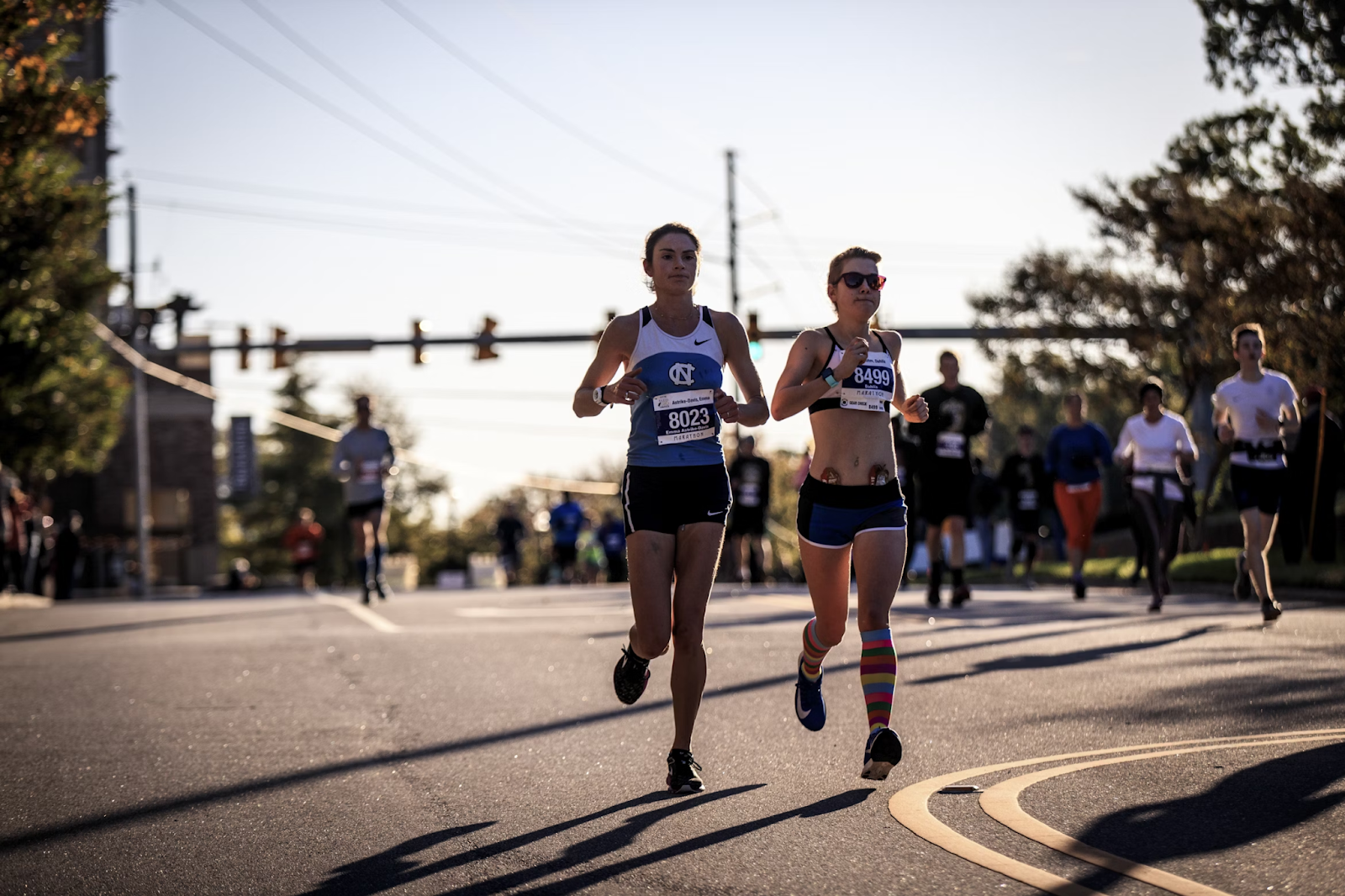From PMS to PB: Doctor Explains How To Harness Your Menstrual Cycle for Marathon Success

April marks marathon season across the UK, with major races taking place in London and Manchester on 27th April. As thousands of runners prepare, many women will be facing an added challenge: Their period.
Evana® has calculated that over 3,000 women could be running the London Marathon while on their period*. In light of this, experts are sharing insights on how menstruation can affect performance and how runners can prepare.
Over two-thirds of female athletes with heavy periods say it impacts their performance — what does this mean for marathon runners?
For those who experience heavy or painful periods, running a marathon while menstruating can pose an even greater challenge. Research shows that heavy menstrual bleeding (HMB) can have a significant impact on female athletes’ training and performance. A study published in the British Journal of Sports Medicine found that 33% of elite British athletes reported experiencing HMB, with 67% of them believing it negatively affected their performance [1].
Period expert explains how to manage a heavy period during a 26-mile run
With 1 in 3 women experiencing heavy menstrual bleeding, managing a heavy flow during the marathon will be a key consideration for some. People with heavy periods may need to change their tampon, pad, or cup as often as every 30 minutes [2]. With the average female marathon time at 4 hours 48 minutes [3], this could pose a major challenge.
“Too many women think they have to put up with the disruption that heavy periods bring.” Explains Anna Maxwell, founder of heavy period relief brand Evana®. “This can lead to them withdrawing from events or never applying in the first place. There is now an over-the-counter treatment to reduce heavy flow, which you can access from the pharmacy when you need it. Knowing your options can help prevent your period from holding you back. Periods don’t have to control you; you can control them!”
Understanding your cycle can help improve performance, says menstrual health expert
For those that don’t have heavy bleeding, periods can still play a role in performance. In fact, each phase of the menstrual cycle brings different considerations for runners.
“The menstrual cycle is believed to affect sports performance due to hormonal fluctuations throughout each phase,” Maxwell explains. “Understanding your menstrual cycle can be key to stronger performance. Simply put, recognising potential symptoms and challenges allows you to take steps to minimise them.”
Evana spoke with Dr Kerry Aston, Consultant Rheumatologist and co-founder of the women’s health platform Nexus, who shared her advice on how to best prepare for the marathon given the phase of your cycle.
Doctor shares her tips on how best to prepare for the marathon given the phase of your cycle
“Your menstrual cycle can impact your race in more ways than you may have thought,” says Dr Aston. “Depending on where you are in your cycle, there are different levers you can pull and factors to consider to help your performance”.
Below, Dr Aston shares her tips for race day according to where you’re at in your cycle:
Menstruation (day one of period, lasting up to 7 days):
“Having your period for race day doesn’t mean you can’t perform well; although for some there may be additional considerations such as heavy bleeding, cramps, fatigue and GI symptoms.
“If you suffer from heavy bleeding and pain, try to create a symptom management plan. There are some great treatments available over the counter – speak to your pharmacist who may be able to recommend what is best for you.
“When on your period, comfort is king. Choose comfortable clothing and secure period products to help reduce leak anxiety during the race.
“To help manage any potential GI issues, stick to easy-to-digest foods that you have tried before. Also consider a longer, gentler warm-up.”
Ovulation (mid cycle when the ovaries release an egg):
“During ovulation, oestrogen peaks which can cause increased ligament laxity and therefore increase injury risk. You should prioritise a thorough warm-up with dynamic stretches and include balance exercises for joint stability. Work hard on maintaining good running form, even in those tough final kilometres and try to avoid sudden pace or stride changes where possible.”
Luteal Phase (after ovulation until your next period starts):
“Racing in the luteal phase can feel tough but with the right strategy you can still perform at your best. During this phase you will likely have a higher body temperature, increased energy needs, and a potential for sluggishness.
“To help mitigate this, you should focus on fuelling your body in the right way. Load up on carbs pre-race; try and develop a plan that works for you whilst training to avoid introducing something new on race day. Hydration is also key; you may lose more fluid in this phase. Try adding electrolytes to your drink and practice your hydration strategy pre-race day.
“To ensure you have enough energy for the whole marathon, focus on pacing. Start conservatively and monitor your heart rate if you can. If you’re at 180 bpm in the first 5K, that pace won’t be sustainable.
“To help manage your increased body temperature, dress in removable layers and consider carrying water to cool down.”
General Training & Race Day Tips
“Track your cycle so you can adapt your training and predict potential challenges.
Practise your full race routine during long training runs — fuelling, hydration, pacing, clothing, symptom strategies. Nothing should be new on race day!
Heavy, painful periods aren’t normal. Don’t suffer in silence — speak to a doctor or pharmacist who will be able to help.”






